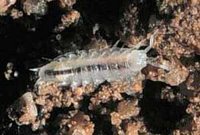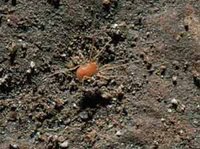 |  |
The park cave with the greatest animal diversity is Clough. This cave is probably home to seven species of invertebrates that live no where else in the world. This includes a scorpion, a harvestmen and several species of spiders. The cave is at low elevation and is warm and seasonally wet. Tree roots provide food for many animals in Clough. Guano from an active bat colony provides additional food for invertebrates. There are several species of bats in Clough, including the rare, Townsend's Big-eared Bat (Corynorhinus townsendii).
Other park caves with unique species include Kaweah, Crystal, Hurricane, Lilburn, and possibly White Chief and Panorama.
Sequoia and Kings Canyon maintain an ongoing research and monitoring program to check on the populations of these animals. This involves more than 60 "plots", small areas of park caves that are checked for the presence or absence of the invertebrates. Sequoia and Kings Canyon National Parks natural resources website
"Not only are these animals new to science, but they're adapted to very specific environments — some of them, to a single room in one cave," said Joel Despain, a cave specialist who helped explore 30 of the 238 known caves in Sequoia and Kings Canyon National Parks. New Animal Species Found in Calif. Caves - Yahoo! News
more at subterranean environments or biological and biology or caves and Troglophiles or Homopterans or Science and National Parks or animal diversity
Related: Keyword biology, Tuesday, January 04, 2005 The Cassini-Huygens mission to Saturn, Sunday, March 20, 2005 Agriculture Secretary Mike Johanns, bovine spongiform encephalopathy (BSE), Thursday, March 24, 2005 Fish Oil Holds Promise in Alzheimer's Fight, Sunday, April 10, 2005 National Human Genome Research Institute (NHGRI), Friday, April 15, 2005 Study uncovers bacteria's worst enemy, Sunday, May 01, 2005 Yes, it is an exoplanet 2M1207 system, Friday, May 20, 2005 a polysaccharide called hyaluronan, Tuesday, May 24, 2005 pseudoneglect phenomenon, Friday, June 03, 2005 DOE JGI sequences DNA from extinct cave bear, Monday, June 06, 2005 From a Few Wild Ancestors, a Citrus Cornucopia, Tuesday, June 07, 2005 NHGRI Selects 13 More Organisms for Genome Sequencing, Sunday, July 24, 2005 Prehistoric Native Americans maize cultivation, Sunday, July 31, 2005 Protein 97 Synapse-associated (SAP97), Sunday, August 07, 2005 universal flu vaccine, Sunday, August 07, 2005 Smoking gun for Alzheimer's disease, Sunday, August 07, 2005 placental tissue, embryonic stem cells, Sunday, August 21, 2005 female senior faculty are still rare, Sunday, September 18, 2005 more rain would benefit New Orleans, Sunday, October 02, 2005 Rapid evolution of the quagga, Sunday, October 30, 2005 , Sunday, November 27, 2005 Give thanks for the cranberry, say dental researchers, Sunday, December 04, 2005 Poison + water = hydrogen, Sunday, December 11, 2005 40,000-year-old human footprints, Sunday, December 18, 2005 warfare in the Mesopotamian world, Sunday, December 18, 2005 Conditions for slavery, Sunday, December 25, 2005 Why Christmas trees are not extinct, Sunday, January 01, 2006 prostaglandins choreograph perturbations, Sunday, January 01, 2006 Cultural differences may explain variations in home remedy use, Sunday, January 08, 2006 Risky Sexual Behaviors in Miami, and Racial Influences on Children’s Care,











No comments:
Post a Comment